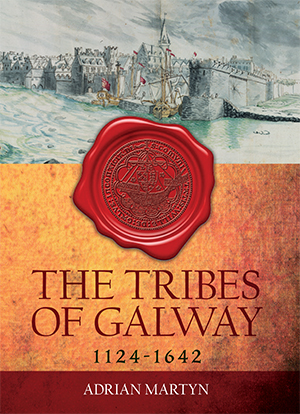THE TRIBES OF GALWAY, 1124–1642
Published in Book Reviews, Book Reviews, Issue 4 (July/August 2021), Reviews, Volume 29 ADRIAN MARTYN
ADRIAN MARTYN
Adrian Martyn
€20
ISBN 9780995502505
Reviewed by Andreas Boldt
Andreas Boldt is a Senior Tutor in German Studies in Maynooth University’s School of Languages.
Adrian Martyn’s The tribes of Galway provides us with a history of the city of Galway—an ambitious undertaking set out in seven chapters. Within these chapters Martyn concentrates on fourteen families from the medieval Irish lower classes who rose to become Galway’s prime merchant families, nicknamed the tribus Galvia in the 1660s. They include those of Athy, Blake, Bodkin, Browne, Darcy, Deane, Font, French, Joyce, Kirwan, Lynch, Martyn, Morris and Skerrett. Over the course of four centuries, they and their fellow Galwegians survived and often thrived against warlords and sieges, during economic booms, busts, famine and plague.
Martyn has tracked the names of the fourteen families into the early medieval period, based on linguistic, cultural and/or occupational traces. And he has performed the rare task of comparing recorded history to family myths while including a valuable genealogy of each family—quite an achievement, since family genealogies are usually limited to the last 200 years or so.
The reader who is interested only in local and family history may be disappointed; Martyn chose not to limit himself to this narrative and instead presents a comprehensive description of medieval life in Ireland from the Gaelic point of view, including culture, habits, language, trade and warfare, something that is generally rare. He makes it clear, too, that the people of Galway saw themselves as destined for something higher, calling the city Connacht’s Rome (p. 9), Communitatis Galve (p. 67) or SPQG (Senatus Populusque Galvianus, p. 196).
In the first chapter, Martyn attempts to determine from where the term ‘Celtic’ and the description of the Irish as ‘Celts’ is derived, in order to prove that this ‘romantic’ view of Irish identity may not be wholly accurate (pp 10–22). He refers to Irish historian Francis John Byrne, who indicated that ‘the Irish had no common (native) word for themselves until they came into contact with foreigners’ (p. 31). According to Martyn, ‘Éire is an island. Its only unity is geographic. Unlike Britain, there was no all-island kingdom or monarchy, only a kingship violently disputed between the major dynasties. Unlike Britain between 1707 and 1800, it has never been a nation-state. Irish “nationalism” was cultural, not ethnic or political’ (p. 37). An eleventh-century text lamented that ‘it is a pity for the Irish that they have the bad habit of fighting among themselves, and that they do not rise all together’ (p. 40). It is therefore not surprising that in the 1470s the term Éireannach (‘Irish person’) was recorded in Connacht. As Martyn suggests,
‘… it emerged within the Mac Uilliam Iochtar lordship of what became County Mayo, from Gaill Gaeilgoiri. While terms such as Gaeil and Gaill were by their very nature exclusive, Eireannach was intended as “a broader, more inclusive term”. It denied neither such ethnicities nor their validity. Instead—by being geographic not ethnic—it gave all an equal claim on their island home and to their version of Irish identity. It is the term as Gaeilge on Republic of Ireland passports today’ (p. 119).
The author not only investigates family history and Irish identity but also, and inevitably for Galway, presents a history of trade. Although the English viewed Ireland as a ‘wilderness’, the Irish managed the environment so well that agricultural production was high, and many goods were shipped and traded to Bristol and London, Nantes and San Sebastian, Waterford and Dublin (p. 61). Owing to constant warfare, armies around Galway were always needed (p. 37). Martyn noted the strong shipbuilding industry and suggested that the Irish could have sailed from Galway to America several centuries before Columbus, but it seems that they were not united and strong enough to undertake an outward expansion. The author also points out that trade made Galway a very international city; for example, several languages—such as English, Latin, French and Spanish—were spoken daily (p. 119).
Overall, I enjoyed this book and I was surprised that it was not more widely reviewed at the time of its publication (2016). The information presented is well constructed, connecting local with national history, family histories with myths and everyday life with ideologies, while critically questioning perceived opinions of Gaelic Ireland along the way. Martyn also deserves credit for his painstaking research on family histories and genealogies. What I particularly liked about the book was the interconnection between local history (Galway), regional history (Connacht), national history (Ireland) and international history (Britain, the European continent, the shores of Africa and America). This placed local history into a new light and showed how interconnected perceived ‘local and island history’ is with the European continent and colonialism. The tribes of Galway connects the history of the city and the fate of fourteen families with worldly events and developments. This book is the first of a trilogy: 1642–1707 and 1707–1924 will follow. If they can deliver the same in-depth study as this volume, I am certainly looking forward to reading them.
















